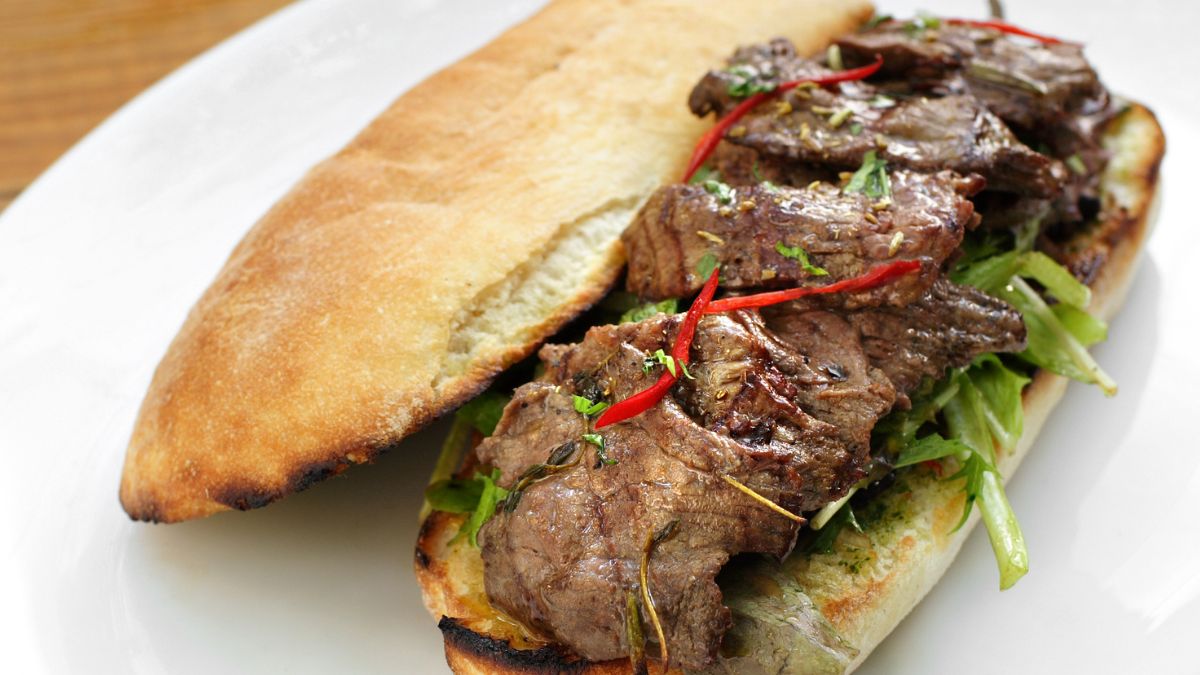What Is the Best Steak for Steak Sandwiches?

To me, a steak sandwich is a steak sandwich, and it equals heaven. I never really cared about which cut the steak came from as long as it was snug between the buns with a juicy sauce and a leaf or two of crunchy lettuce. But ever since my friend made a flank steak sandwich for me and explained the differences, I found out that the steak changes everything when it comes to a sandwich.
To save you time and help you skip to the good part, in this article, I will tell you all about the best steak cuts, how to make them, and how to combine them.
Ribeye Steak

A classic beef ribeye cut has excellent marbling, making it a great choice for steak sandwiches. The marbling in the meat adds flavor, juiciness, and some fattiness. Still, the marbling doesn’t make the cut fatty in the traditional sense, but it intensifies the flavors, both natural and added after you cook it.
The ribeye cut is rich, almost buttery, very flavorful in itself, and exceptionally receptive to flavors you may add. It has a tender texture, is easily chewable, and is very convenient to bite, which is extremely important when talking about steak sandwiches. For me, these features of ribeye cut are probably the most important ones, as I really can’t enjoy a steak sandwich with a steak that is hard to bite and chew.
When cooking ribeye steak, it is best that you use a fresh cut rather than frozen, so if you can choose, choose the fresh one. Still, whether fresh or frozen, you will be having a steak that has been in the fridge. So, another trick I’ve learned is to let the ribeye steak sit at room temperature for about ten to 15 minutes so that the entire piece is at the same temperature.
Of course, if you use a frozen cut, you will have to defrost it first, so these ten to 15 minutes start running once the meat is properly thawed.
You can use this time to allow for the steak to take the seasoning, so rub salt and pepper on it before letting it sit at room temperature. The next step is to cook it. Usually, ribeye steak is not fried but seared; in that way, the meat is at its juiciest, which is better known as rare to medium rare.
Still, you can cook it to the extent to which you like it most. If you sear it, you should allow it to cook for about three to four minutes on each side. If you like it well done, you should cook it for about six to seven minutes on each side.
No matter how long you cook the ribeye steak, always let it sit and rest for about five minutes before you cut it. Cut it into thin slices and layer them between the buns. Add your favorite sandwich ingredients and enjoy your steak sandwich.
Flank Steak

This is a leaner cut bursting with flavor. While ribeye cut can praise itself with a more vibrant texture, flank steak advertises as the flavorful one. It is bold and beefy with a chewy texture that is just perfect with crispy bread and fresh-tasting toppings.
Flank steak can be a little uncomfortable since it isn’t fatty, so the cut tends to stiffen when cooked. It isn’t that it will be impossible to chew it, but it won’t separate easily. So, I recommend you marinate it before cooking.
I use olive oil, balsamic vinegar, and some mustard to marinate it but feel free to browse the web and choose the marinate that best suits you.
Covering and refrigerating the flank steak for at least one hour is essential, no matter which marinades you use. Remove the steak from the marinade and pat it dry with paper towels before cooking if you can leave it overnight, even better.
This cut does best when grilled. If you can grill it, then great, but if you can’t, the next best thing would be to sear it on a grill pan or broil it. Cook it for about 4-5 minutes on each side or longer if you want it well done.
Although you can combine the steak with your favorite sandwich ingredients and bread, I like it best between ciabatta slices topped with fresh arugula, roasted red peppers, and a drizzle of balsamic crème.
Skirt Steak

This is a long, thin cut of beef with bold and assertive flavor and tender texture. It has an expressive beefy flavor and is decently easy to chew, which makes it a great sandwich meat option.
It has a good amount of marbling, though lesser than the ribeye cut, which means that its natural flavor and juiciness need some additional boosting to bring them out to the fullest. So, while seasoning ribeye steak in advance is desired but not necessary, seasoning skirt steak before cooking it is a must.
I like rubbing some mustard, salt, pepper, and powdered garlic into the steak and leaving it for about 15 minutes to take the seasoning.
As with the other steaks, you can cook this one as long as you need to achieve the flavor you enjoy the most. I find it most delicious when it is medium rare (so after four to five minutes of searing per side), but feel free to explore and find your perfect balance.
My favorite sandwich with this type of steak is a lightly toasted baguette with a layer of garlic aioli on one side topped with thinly sliced steak and sautéed sliced onions. I also like to add sliced tomatoes and arugula for a crunchy bite.
